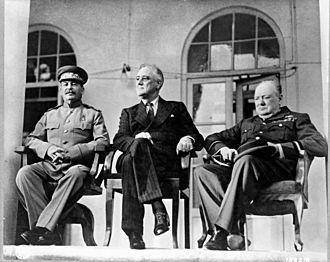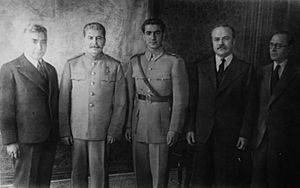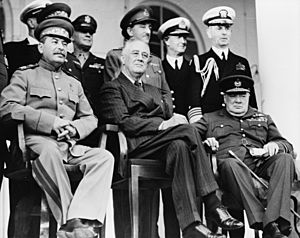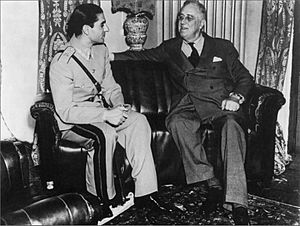Tehran Conference facts for kids
Quick facts for kids 
The "Big Three" (Stalin, Roosevelt, and Churchill) at the Tehran Conference
|
|
| Date | November 28 – December 1, 1943 |
|---|---|
| Venue | Soviet embassy |
| Location | Tehran, Iran |
| Also known as | Eureka (codename) |
| Type | Allied World War II conference |
| Participants | |
| Outcome | Consensus to open a second front against Nazi Germany by 1 June 1944 |
The Tehran Conference was a very important meeting during World War II. It happened in Tehran, Iran, from November 28 to December 1, 1943. The three main leaders of the Allied powers met there. These leaders were Joseph Stalin from the Soviet Union, Franklin D. Roosevelt from the United States, and Winston Churchill from the United Kingdom. They were often called the "Big Three."
This meeting was the first time all three leaders met together during the war. They talked about how to defeat Nazi Germany and what the world might look like after the war. A key decision was to open a "second front" against Germany. This meant the US and UK would invade France to take pressure off the Soviet army fighting in the east. They also discussed plans for Turkey and Iran, and what to do about Japan.
Contents
Why the Leaders Met
Planning for a Global War
When Germany attacked the Soviet Union in 1941, Britain quickly offered help. Later, when the United States joined the war, all three countries needed to work together. They formed a committee to plan their military actions.
However, fighting a war all over the world was very complicated. The Allies didn't have one clear plan, and they argued about how to share resources. This led to some distrust between the Western Allies (US and UK) and the Soviet Union.
The Need for a Second Front
One big issue was the "second front." The Soviet Union was fighting fiercely against Germany on the Eastern Front. They wanted the US and UK to open another front in Western Europe. This would force Germany to split its forces, making it easier for the Soviets.
Another challenge was how to help each other. Both Britain and the Soviet Union needed supplies and money from the United States. Also, the US and UK didn't want Stalin to have too much power in Eastern Europe after the war. They also disagreed on what to do with Germany once the war ended.
Getting the Leaders Together
The leaders had been sending messages back and forth, but they really needed to meet in person. Stalin didn't like to fly and preferred to stay in Moscow. Roosevelt had health issues that made travel hard. Churchill loved to travel and had met Roosevelt many times before.
Roosevelt tried to get Stalin to meet in places like Cairo or Baghdad, but Stalin said no. Finally, Stalin agreed to meet in Tehran, Iran, in November 1943.
What Happened at the Meeting
The Leaders Arrive
The conference started on November 28, 1943. Stalin arrived early, and Roosevelt, who had traveled a very long way, came next in his wheelchair. This was the first time Roosevelt and Stalin met. Churchill arrived a little later with his military team.
Many important people were with the leaders. Roosevelt had his personal helper, Harry Hopkins, and the US Ambassador, Averell Harriman. Stalin was with his Foreign Minister, Vyacheslav Molotov. Churchill brought his Foreign Secretary, Anthony Eden, and top military advisors.
Key Decisions Made
Stalin was very happy because his main goal was achieved: the Western Allies agreed to open a second front. This meant they would invade northern France. Stalin also agreed that the Soviet Union would join the war against Japan once Germany was defeated.
The leaders also talked about Poland's borders. They decided to move Poland's eastern border closer to a line suggested by British Foreign Secretary Lord Curzon in 1920. To make up for this, they agreed to move Poland's western border further into Germany, along the Oder and Neisse rivers. This decision was officially confirmed later at the Potsdam Conference in 1945.

Planning the Invasion of France
Churchill had wanted to focus on fighting in the Mediterranean Sea first. But Stalin kept pushing for a direct invasion of France. It was finally agreed that a major invasion, called Operation Overlord, would happen in May 1944.
To help with this, Stalin promised that the Soviet forces would launch a huge attack on Germany's Eastern Front at the same time. This attack, called Operation Bagration, would stop Germany from moving troops to France. They also discussed other attacks, like invading southern France, to draw German forces away from the main landing areas.
Discussions about Iran and Turkey
The leaders also talked about Iran and Turkey. They all agreed to support the Iranian government. They promised to keep helping Iran with money and supplies, especially because the war had caused many economic problems for the country.
The Soviets also promised to help Turkey if it joined the war against Germany. The leaders hoped Turkey would join the Allies before the end of 1943. They even offered Turkey some islands, like Crete and the Dodecanese, to encourage them.
A Special Dinner Meeting
During a dinner on November 29, 1943, Churchill gave Stalin a special sword. It was called the "Sword of Stalingrad" and was a gift from King George VI to honor the Soviet victory at the Battle of Stalingrad. Stalin kissed the sword's cover when he received it.
At this dinner, Stalin also said something important:
Without American machines the United Nations never could have won the war."
There was also a serious discussion about how to deal with German military leaders after the war. Churchill strongly disagreed with some ideas, saying that only war criminals should be put on trial. He was very upset, but Stalin later said he was just joking.
Agreements Made
On December 1, 1943, the three leaders announced their decisions.
Military Decisions
- Yugoslavia: The Yugoslav Partisans, who were fighting the Germans, would get full support with supplies and equipment.
- Turkey: It was agreed that Turkey should join the war on the Allied side soon. If Turkey went to war with Germany and Bulgaria attacked Turkey, the Soviet Union would immediately declare war on Bulgaria.
- Invasion of France: The main invasion of France (Operation Overlord) would happen in May 1944. Another attack on southern France (Operation Dragoon) would happen at the same time. The Soviet Union would launch a big attack (Operation Bagration) on the Eastern Front to keep German troops busy there.
- Military Cooperation: The military teams of the three countries would stay in close contact to plan these operations. They would also create a plan to trick the enemy about where and when the attacks would happen.
Political Decisions
- Poland's Borders: Stalin and Churchill discussed Poland's future borders. They agreed on the Curzon Line in the east and the Oder-Eastern Neisse Line in the west. Roosevelt chose not to be part of this discussion because of Polish voters in the US and an upcoming election.
- Baltic States: Roosevelt wanted the people in Lithuania, Latvia, and Estonia to vote on whether they wanted to be part of the Soviet Union again. Stalin said that these issues would be handled according to the Soviet Constitution.
Outcomes of the Conference
Support for Yugoslavia
The Yugoslav Partisans received full Allied support, and aid to another group, the Yugoslav Chetniks, was stopped. The Partisans, led by Josip Broz Tito, eventually took power in Yugoslavia as the Germans left.
Turkey Joins the War
The President of Turkey, İsmet İnönü, met with Roosevelt and Churchill. He promised to join the war once his country was fully armed. Turkey broke off relations with Germany in August 1944 and declared war on Germany and Japan in February 1945. This allowed Turkey to join the future United Nations.
Operation Overlord Launched
Roosevelt and Stalin worked hard to convince Churchill to commit to the invasion of France. They succeeded on November 30, when Roosevelt announced that the invasion would happen in May 1944. This made Stalin very happy, as it would relieve pressure on his troops. This decision was one of the most important outcomes of the conference. It helped the Soviet army push back against Germany, a turning point in the war.
Beginning of the United Nations
The Tehran Conference was also one of the first times the idea of the United Nations was discussed. Roosevelt suggested an international organization where all countries could solve problems and stop aggressive nations. All three leaders agreed that something needed to be done to prevent another world war like the one they were in.
Future of Germany
The leaders generally agreed that Germany should be divided after the war to prevent it from starting another conflict. They discussed different ways to divide it. While their specific plans didn't happen exactly as discussed, Germany was indeed divided into two parts after the war until the end of the Cold War.
Soviet Entry into the Pacific War
Roosevelt asked Stalin for information about Japanese ports and air bases in Siberia. Stalin later told the American ambassador that the US could use 1,000 bombers from Siberia once the Soviet Union declared war on Japan.
Alleged Assassination Plot
Some Soviet reports claimed that German agents planned to kill the "Big Three" leaders at the Tehran Conference. However, this plot was supposedly stopped while still in the planning stages.
The Soviet secret police, the NKVD, told Roosevelt's security chief, Mike Reilly, about the suspected plot. They said that German agents had been parachuted into Tehran. The NKVD suggested that Roosevelt move to the safer Soviet or British embassy.
Americans, however, suspected that Stalin might have made up the plot. They thought he wanted Roosevelt to move to the Soviet embassy so he could spy on him more easily. Roosevelt didn't believe there was a real threat, but he agreed to move. This allowed him to be closer to Stalin and Churchill for meetings. It also helped him build trust with Stalin. The Soviet embassy was heavily guarded, and it was next to the British embassy, making it a very secure place for the leaders to meet.
After the conference, a Soviet official admitted that they knew about German agents in Tehran, but not about a specific assassination plot. Many American and British intelligence reports also doubted the plot's existence. The alleged leader of the operation, Otto Skorzeny, later said that Hitler had dismissed the idea as impossible.
|



